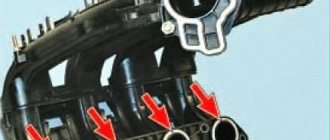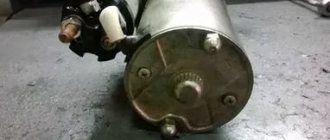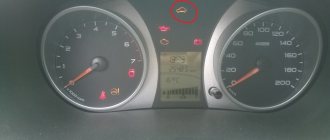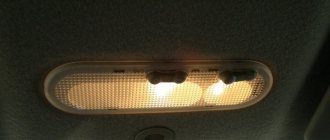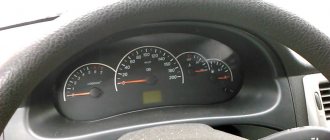When I bought the car, I immediately noticed that the revs were floating at XX. Since the car as a whole is very good and inexpensive, I decided to take it with this problem. It runs well on the highway and runs fine at revs. Now attention! Car 1.6 8 cl. E-GAS. mileage 60 thousand. In the morning it starts 3-4 times
.
It starts and stalls. Then I press the gas and it seems fine. DVT, CANDLES, WIRES, new. If it starts and runs for a while, it starts up normally, but the starter still turns 2-3 turns. Doesn't work smoothly at idle!
I connected the ELM-327 - misfires occur. then in 1, then in 2, then in 3, then in 4. But more in cylinder 1... I warmed up the car to 90 degrees, and the misfires almost disappeared. Well, one or two will slip by, every 3-5 minutes. If the temperature is 60-70 degrees, then gaps constantly flash. What to do? Is this a valve? There is no camshaft sensor on this car. I did not measure the pressure in the fuel rail.
Addition ! Cleaned the injectors and remote control. The injectors were purged with ABRO liquid for cleaning carburetors. I removed the throttle and doused it all with this liquid. one place shines like a cat's) Result. It started the first time, but it still cranked for about two seconds, they suggested that this is a feature of gas - there is no phase sensor and because of this it cranks longer. the gaps became much smaller, but they remained. I'll clean the injectors again when it gets warmer. So we can say the problem is solved.
Main prerequisites
The engine does not start the first time
Kalina has a fairly common reason that it does not start the first time. This is due to design, wear and tear and electrical issues. However, it is worth breaking down the difficulties into categories and looking at them in more detail. What is needed, let’s look at the main categories into which this malfunction is divided:
- Problem with the fuel system.
- The reason is the ignition.
- Damage to timing parts.
- Problem in the operation of electrical circuits and ECUs.
When what remains to be done for our client is disassembled into its prerequisites, it is worth looking at them in more detail, which initially is how to remove them from the car.
Spark plug
If everything is in order with the electronic filling, you should look for the problem in the candles. Often, and especially in winter, it floods.
Compression in the engine in cold weather does not meet the standards, so the engine may not start immediately. Often flooding of spark plugs occurs due to a discharged battery, which is unable to produce a normal spark. If not, the reasons may also be in the wiring or the spark plugs themselves. The easiest way to dry the spark plugs is to press the gas to the floor and crank the engine with the starter two or more times. Often, after this the car will start. If this does not help, then for more thorough drying you should dismantle the spark plugs, then clean them, check the gap, and then dry them with a hairdryer or in the oven.
Fuel system
The first reason that a car may not start the first time is the fuel system. A missing amount of fuel or a very large supply of gasoline becomes a problem. Then the starter turns, unfortunately starting is difficult. If the starter does not turn and the immobilizer icon is flashing, then there is a problem with the unknown immobilizer.
See:
Fuel pump wear
A breakdown of the fuel pump or a clogged fuel filter may result in insufficient pressure in the fuel line and the mixture comes out lean. Accordingly, a small amount of fuel in the combustion chambers is not enough to start the engine . When a lot of fuel is supplied, the spark plugs are simply thrown and there is no spark to ignite, which is a prerequisite for the engine not starting.
Ways to solve the problem
So, you have already become familiar with the main prerequisites for breakdown. Now let's move on to direct work with engine components. To diagnose the system at home:
- Remove the fuse. Carefully examine all system components at the time of damage. To find out which fuse controls which element, examine the back of the cover. Let's check the safety elements responsible for the immobilizer ignition coil, battery, fuel pump and starter. If no damage is found, then proceed to the next step.
- We check the fuel system. To do this, you will need to disassemble the fuel pump by removing it. If the fuel pump components are working normally, install it in its original place. We check the condition of the injectors and replace the fuel filter with a new one.
- We remove the wiring block from the car’s cooling system sensors and try to start the engine. Checking the cooling system sensor. If the indicators are significantly lower or higher than normal, it means it is not working correctly.
If you have not been able to identify the problem, but the vehicle is still not functioning correctly, it is advisable to completely disassemble the engine and examine the condition of each of its components in more detail. Be sure to wash all auto parts. Replace faulty parts with new ones and remove rust stains.
Replace bearings and bushings only in pairs. Otherwise, the starter may jam. Change the self-timer magnets together with the housing glass.
It is not advisable to solder the parts, as they may fall off when the temperature rises. Installation of parts is carried out using welding. Accordingly, to carry out the work you will need a special puller, tester, press and welding machine.
Gas distribution mechanism
More than once in the manuals it is found that the start-up is not the first time due to incorrect operation of the gas distribution mechanism. Initially, this is due to carbon deposits that appear on the valves, and additionally due to incorrect operation of the gas dispersion phases. The malfunction should be found in the camshafts, and of course the position of the crankshaft relative to the camshaft.
The next prerequisite will be wear of the timing belt and pulley. A stretched belt can disrupt valve timing. It is worth checking and, if desired, installing a new timing belt repair kit.
Why is the VAZ 2114 8-valve injector difficult to start?
For some reason, it seems that many drivers of this model will be interested in the question of why the VAZ 2114 8-valve injector does not start well. Finding the cause of this phenomenon is not as easy as it might seem at first. This is due to certain difficulties in troubleshooting in this model, since injection systems differ from carburetor systems. The algorithm for identifying possible problems will be built differently, adapting to the design features of the machine.
Why is the VAZ 2114 8-valve injector difficult to start?
, we will try to consider in this work. In a short article it is impossible to consider absolutely all possible problems; there are some that can only be identified with the help of diagnostic equipment. But, nevertheless, we will try to analyze as many such situations as possible in order to help all VAZ 2114 owners decide what to do in such a situation.
Why might the engine be difficult to start?
You can look for the culprit in such a situation in several directions. Among them, the most important problems are:
- Malfunctions in the ignition of a VAZ 2114 car
- There is no pressure in the fuel rail of the 8-cl VAZ engine
- Air leak into the VAZ intake manifold
- Timing belt marks are misaligned
Engine diagnostics using spark plugs
Let's look at the first option, why the VAZ 2114 doesn't start well. To do this, unscrew the candles and look at their color. If there is black dry carbon on the candles, we can say that the engine has been running for a long time on a rich mixture, which covers the candles with black carbon.
Why does black carbon appear on the spark plugs of an injection car:
- Malfunction of the mass air flow sensor
- The first oxygen sensor has failed
- Fuel pressure regulator is faulty
- Malfunction of fuel injectors
White carbon deposits on the spark plugs of an injection car appear due to a lean mixture, the reasons for the appearance:
- Everything is the same as with black soot
- Malfunction of the fuel pump or clogged fuel filter (check the mesh and fine filter)
- Air leaks through the air flow sensor pipe, the place where the regulator is attached to the XX joints of the manifold.
Checking the spark plug spark
The lack of a spark on one 8-cl spark plug of a VAZ engine will not affect the engine starting, it will be noticeable when idling, tripping and jumping revs. But if the ignition module of the VAZ 2114 is faulty, then the spark disappears in two cylinders 1-4 or 2-3. To check the spark plug spark, take out the fuel pump fuse, unscrew one spark plug or take a spare one, remove the high-voltage wires one by one, put them on the spark plug, then put the whole thing on ground (in this case, the valve cover) and ask a friend to crank the engine with the starter, so we check each spark plug. If there is no spark on one spark plug, most likely there is a defect in the explosive wires; if there is a spark in two or all spark plugs, it is highly likely that the problem is in the ignition module or the wiring to it.
The timing marks on the VAZ are not set correctly
Another reason why the VAZ 2114 does not start may be a mismatch of the timing marks. The reason for the mismatch of the marks may be weak timing belt tension, cut teeth, or the crooked hands of a mechanic at a service station.
A discrepancy of more than two teeth will noticeably affect the operation of the engine of the fourteenth. With a slight deviation, the engine starts up a little worse, does not hold idle, and stalls when switching to neutral gear. If the deviation exceeds 4-5 teeth, the sound of the engine changes, air escaping under pressure through the valves that are not opened in time becomes audible, thrust noticeably disappears, and starting the engine is extremely problematic.
- To check, we need a “10” key; use it to unscrew the three bolts securing the timing case.
- Next, put the car in 5th gear and push it until the mark on the camshaft pulley and the rear cover match, you can also turn the pulley with the key to “17”
- We remove the protective plug from the clutch housing and see if the mark on the flywheel matches the mark; if not, then you need to loosen the tension roller and align the belt according to the marks.
Electrics
The last reason why such a malfunction occurs is electronic parts and circuits. So, the problem may lie in the starter, electrical control unit or wiring. We discard the main cause of the battery, since if it is dead, then the car will not start the second time. Let's look at what remains for our client to do separately.
Starter
Problems in the work and failure of parts of this unit can be a prerequisite for a disgusting start-up.
So, a breakdown of the solenoid relay or bendix may be a prerequisite for the fact that the Kalina will not start the first time. Also, it is worth checking the wires, which may oxidize and skip contacts once.
Wiring
Breakdowns and problems in the wiring may vary and serve as a prerequisite for the fact that the car will not start the first time. So, it is worth finding the problem between the battery terminals and the starter, and also the ignition coil and spark plugs.
Soot on the candles will serve as a prerequisite for a disgusting engine start
The electrical control unit is the main reason why the car does not want to start the first time. Thus, many errors lead to the issuance of incorrect commands. For example, the amount of fuel being distributed is incorrect or the consistency is enriched. It is worth getting into the ECU if the fuel system, ignition and starter have been tested. The cause is eliminated by resetting the errors or changing the firmware.
Electrical control unit errors
How and why the immobilizer fails
Let's dwell on this topic in a little more detail. The thing is that the ECU controller on this model is located under the heater radiator. In second-generation models, the controller was moved.
So, if the Kalina does not start, you need to remove the side wall from the left side in the passenger seat and visually check the ECU. The block must be dry. If it is wet, then it is filled with coolant - in this case, it will not be possible to restore the ECU, only replacement will help.
First of all, when exposed to liquid, the output switch burns out. The chip can be re-soldered, but after such repairs the problems will go away for literally two months, and then they will appear again. The heater radiator will need to be replaced. If this problem exists, then experts recommend installing a new controller between the engine compartment partition and the stove.
Now about the immobilizer - in Kalina cars the manufacturer installs APS-6 immobilizers. In very rare cases, these devices fail on their own. Often, the problem is hidden in the wiring or control panel. The key fob body is held together with one self-tapping screw - the screw can be overtightened or undertightened. A crack appears on the remote device chip between the transponder contacts. In this case, if the Kalina does not start, only a spare or training key, or replacing the remote control will help.
Conclusion
Thus, the Lada Kalina will not start the first time
for several reasons. The main ones are a breakdown of the fuel system, accounting programs, errors in the electrical control unit and another breakdown of the starter. Some car owners note that there are cases when this effect appears due to wear on the flywheel rim. Always, if a motorist is not sure that he will be able to cope with a malfunction without the help of others, then it is worth contacting specialists at a car service center.
Many car enthusiasts have encountered a problem when the Lada Kalina does not start the first time. There may be various reasons for this, which need to be known and eliminated in time. In this article, we will look at the main reasons that the car does not start the first time and methods for eliminating these faults.
Bendix replacement
The most common cause of engine failure with a rotating starter is considered to be a broken bendix. Its cost is low, so there is no point in repairing the part. Literally speaking, Bendix is considered a consumable. Replace it by following simple instructions:
- We remove the old starter. We disconnect the negative terminal from the battery in advance and get rid of all fastening bolts and nuts using a screwdriver and wrench.
- The retractor unit also needs to be removed.
- Disconnect the traction relay from the housing. It must first be disassembled.
- We take out the starter entirely, removing the fastenings. Let's put it aside.
- We find the retaining ring and dismantle it. We remove the bendix.
Reassemble the mechanism in reverse order and start the car. If no errors were made during assembly, the car will start quickly. The main thing is to choose a new starter that is identical to the original one.
To summarize, we note that the cause of a breakdown is not always an engine malfunction. Identifying the “sore spot” is possible only with an integrated approach. If you do not have enough experience and are afraid of making things worse, then it is better not to attempt to repair your vehicle yourself.
Main reasons
The engine does not start the first time
Kalina has a fairly common reason that it does not start the first time. This is due to design, wear and tear and electrical issues. But, it is worth breaking the problems into categories and considering them in more detail. So, let's look at the main categories into which this malfunction is divided:
- Problem with the fuel system.
- The reason is the ignition.
- Failure of timing elements.
- The problem is in the operation of electrical circuits and the ECU.
When everything is sorted out into the causes, it is worth considering them in more detail and how to eliminate them on the car.
Fuel system
The first reason that a car may not start the first time is the fuel system. Insufficient fuel or too much gasoline becomes a problem. In this case, the starter turns, but starting is difficult. If the starter does not turn and the immobilizer icon is flashing, then the problem is already on the immobilizer side.
Lada Kalina starts poorly and stalls when cold
Car: Lada Kalina, 2008. Asked by: Anonymous. The essence of the question: is it difficult to start when cold?
When cold it starts poorly, once started the revs increase sharply, then it stalls, the check engine light does not come on. When warmed up it works perfect. TPS and IAC replaced.
- 1 Mass air flow sensor as a problem area for poor engine starting
Mass air flow sensor as a problem area for poor engine starting
Most likely the mass air flow sensor is faulty. If the TPS and IAC are replaced, and you are confident in their performance, then there are no other options. It is best to look at the parameters of the mass air flow sensor when starting on a cold one, which it produces.
Your symptoms are similar to incorrect readings from this particular sensor.
MAF Lada Kalina close up
Mass air flow sensor is one of the most expensive sensors in a car.
If the mass air flow sensor is working properly, then the fault is air leaks or the ECU.
Eliminating air leaks
Air leaks are another common cause of engine starting problems. If you are choking on air or even freezing, rest assured that it is an air leak. You need to look in the following places:
- through the intake manifold gasket;
- vacuum booster;
- throttle valve gasket;
- absorption valve;
Carefully check all these elements, as well as the condition of the gaskets. Go through all the ducts, maybe damaged somewhere. The suction system tubes must also be intact. Don't forget about them. You can also use the following method: start the engine, let it run, then walk around the car and listen, hoping to hear the characteristic sound of an air leak.
It will be sparkling. Then we clamp the pipes that go into the intake manifold. Having clamped the hoses, we monitor the operation of the engine. If there are any changes, there is a leak in the area of the vacuum booster and pressure regulator. In general, this problem is quite serious and requires a lot of time and perseverance. You can totally do this yourself.




